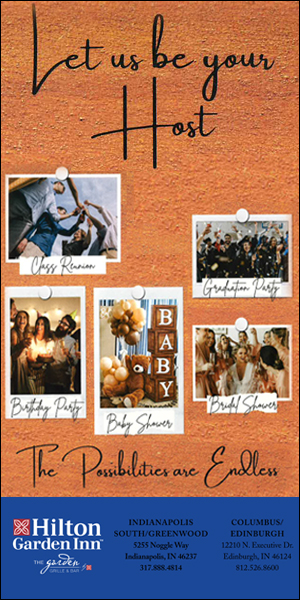
A local handbell choir transforms the Old World ring of bells to modern-day music for the ears
By Teresa Nicodemus | Photography by Mark Freeland
June Hannah’s first experiences with handbell ringing in junior high school formed her love of music early on and helped to shape her later career path. Hannah participated in choirs at school and church as a youth, and she later majored in music education while studying at Ball State University.
She has been directing church choirs for the past 30 years, perfecting her handbell ringing skills through solo and ensemble performances.
In 1999, Hannah fulfilled a lifelong dream by founding Joyful Sound, a group of talented bell ringers on the southside. “When I first started recruiting members, I contacted people that had been in my handbell choir at church and also contacted directors that had advanced choirs in the area to see if they or their ringers were interested,” she recalls. “We began with 12 members, and currently we have grown to a 15-member choir.”
Once the group was established, auditions were scheduled and continue when an opening arises. The audition process requires potential ringers to participate in three consecutive rehearsals. “This way we can see if they are good ringers, good sight (music)-readers and this helps determine their commitment level and how their personality fits in with the rest of the group,” explains Hannah. “After that three-week period, we decide as a group if we think they are committed, can work well with us and have the skills to ring the level of music that we perform.”
The first year of Joyful Sound’s development was focused on the business side of the choir, defining the mission statement, establishing the name and logo, and finding a place to borrow handbells and rehearse. Community Church of Greenwood offered its facility and use of its handbells for the fledgling group until the bell ringers could afford their own. “The handbells and the chimes we use are quite expensive,” Hannah explains. “We finally purchased all of our equipment using donations given to us from concerts and also a large gift … given by my dad, George Norton, through his foundation. We are supported through donations at our concerts and also earn money by doing recordings for various national publishing companies.”
Joyful Sound has performed at the Indiana State Museum, the Indianapolis Children’s Museum, The Rhythm Discovery Center in Indianapolis and at
weddings, churches and nursing homes.
“Handbells can be rung using different techniques notated by different symbols on the sheets of music,” explains Hannah. “We may shake the bells or use soft mallets to strike the bells for a unique sound.”
The group also uses hand chimes, “which look like large tuning forks and offer a very pure sound — almost like the sound of an organ,” she adds. “We may play one instrument or the other or at the same time.”
Joy Whitesell, one of the first members of Joyful Sound, still plays for the group. Her love of handbells and the group’s challenging scores inspire her musical talents. “Being involved with Joyful Sound offers more than playing in a normal church handbell choir,” she says. “It offers something deeper. We can play more difficult pieces.”
Setting up the handbells and chimes for each concert and carefully packing the instruments away in cases is an art in itself. Joyful Sound members work together to arrange the table for each performance. Each table is topped with a heavy foam hidden under a skirted tablecloth to both protect the delicate bells and serve as a sound barrier. Mallets are placed at each bell ringer’s station, and acrylic stands are set up to hold sheets of music. Every member wears a pair of gloves when performing. The gloves serve dual purposes to protect the bells’ casting from oils on the skin and to cushion the bell ringer’s hands.
Each set of bells is laid out in chromatic order around the table. “There is a separate set of bells for each key, just like the keys of a piano,” explains Lindsey Fischer, who has been a Joyful Sound bell ringer since 2004. “Every set of bells represents one key on a piano. The smaller bells ring a higher pitch, and the large bells, which can weigh up to 13 pounds, ring at a lower pitch.”
Each ringer, according to Fischer, reads from the same music and is responsible for picking out the musical notes corresponding to his or her two bells or chimes. “We don’t pick our positions to play, but we play where needed with the exception of the larger bells,” Fischer says. “The guys that play those, play those particular bells because they are heavy. And, at times, a song calls for playing two bells or three bells in each hand instead of one. This takes a particular music reading skill and coordination that not every member has. This can influence what position a bell ringer will play in the group.”
The group is tight-knit, Fischer says. “We have a lot of fun, yet take the art of bell ringing seriously. Not many groups in this area can play music at this level of difficulty. We strive to produce quality music and represent this musical art form in the community.”
The group performs a couple of concerts each fall and spring, with several shows scheduled around the holidays in December.
This year, Joyful Sound is celebrating its 15th anniversary. The group commissioned music composer Jason Krug to create an original composition in commemoration of the anniversary. Joyful Sound debuted the score at its first fall concert at St. Mark’s Catholic Church in October.
“The highlight for me at every concert is seeing the faces of the people hearing the handbells and chimes for the first time,” Hannah says. “We will take the chimes out to the audience to try, and we explain the instrument to them. We hold interactive performances with the audience. During our concerts, the audience gets a background of each song. It’s not just a performance; it’s an education as well.”


